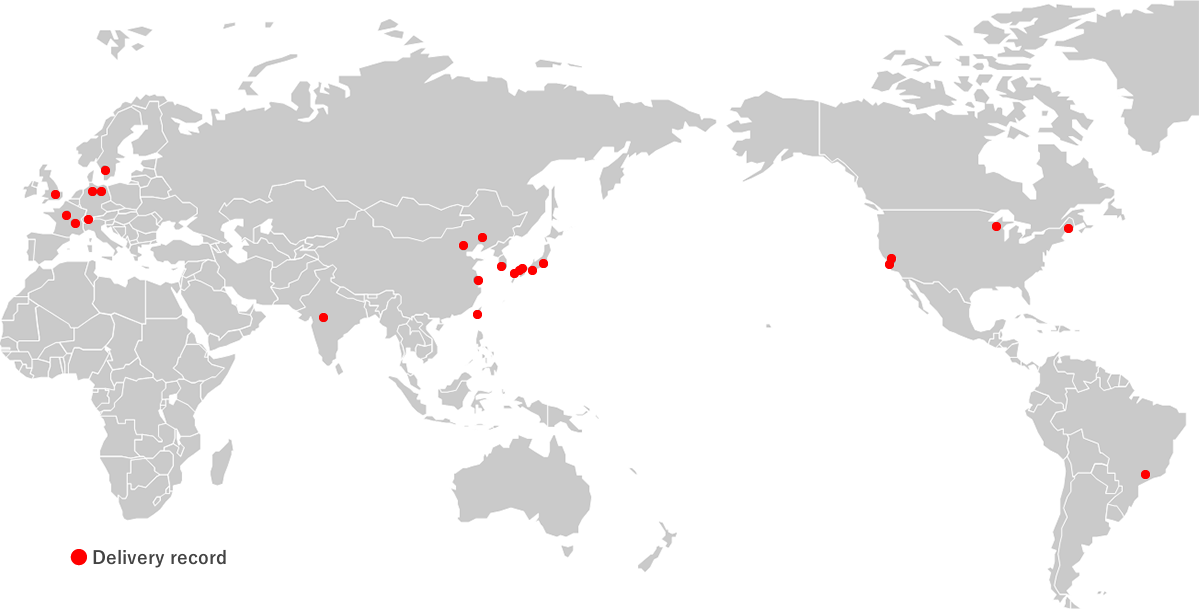OpticalOptical
JTEC Corporation high-precision X-ray mirror
High-precision X-ray mirrors are used in large synchrotron radiation facilities as one of the important optical instruments that reflect the synchrotron radiation beam to the target. There are different types of collector mirrors and spectroscopic mirrors depending on the purpose.
High-precision X-ray mirrors contribute to many research achievements in fields, such as life science, materials science, earth science, and environmental science.

JTEC Corporation provides a maximum of 1 m long X-ray mirrors with a shape error of ±1 nm. For example, if a railroad is laid between Tokyo and Osaka 500 km, this is equivalent to ±0.5 mm of height difference. As our advantage, we can provide not only flat shapes but also free curved surfaces, such as elliptical, cylindrical, toroidal and ellipsoidal surfaces.

What is synchrotron radiation?
Synchrotron radiation is an artificial electromagnetic wave (light) that is generated tangentially when the trajectory of a high-energy electron beam is bent by a strong deflecting magnet. Synchrotron radiation has excellent characteristics, such as brightness (extremely bright) and directivity (extremely narrow and difficult to spread). The higher the electron energy, the shorter the wavelength of light, such as X-rays.


Research results using synchrotron radiation
Recent research results using synchrotron radiation include basic and applied research such as protein structural analysis of atomic arrangements, 3D structures of particles recovered from the asteroid Itokawa, structural determination of the regular growth of nanocrystalline composite thin films. It is also widely used in industrial fields such as visualization of the chemical state of platinum catalysts in fuel cells and new material development technology for high-performance tires.
Life science

- Development of x-ray microscopy for 3D cell imaging
- Structural Analysis of Protein Complexes
Material science / Industry use

- Development of high capacity nickel-metal hydride battery
- Analysis of the internal structure of hair for the development of hair care products
- New method of 3D measurement for development of fuel-efficient tire
Environmental science / Geoscience

- Reproduce the environment inside the earth, it suggests that the outer core may be convected in two layers.
- Particle analysis of asteroid Itokawa
Archaeology science

- Analysis and appraisal of criminal investigation
- Investigation of archeological materials by X-ray fluorescence analysis
- Identify raw materials based on debris peeled from old wooden surface
Synchrotron radiation facility

A large synchrotron radiation facility can be compared to a “giant microscope.”
To observe the world of atoms and molecules, we need strong light (X-ray) that illuminates the microscopic world inside the material. This can be realized using strong, high-luminance X-rays from a large accelerator with a special bending electromagnet.
The synchrotron radiation facility is a research facility where microstructures can be examined by applying synchrotron radiation to the sample material. Electrons emitted from the electron gun are accelerated to values close to the speed of light, and powerful radiation can be obtained by using a deflecting electromagnet and an insertion light source device. The synchrotron radiation travels from the storage ring to the experimental line (beam line) allocated radially and is used for diverse research and analysis.


Our high-precision X-ray mirrors are used in the beam line for the purpose of focusing, spectroscopy, and imaging. As an example of use, a high-precision KB mirror can be installed in front of a test sample, and X-rays can be focused at nano scale to achieve higher resolution.


SPring-8

SPring-8 is a large-scale synchrotron radiation facility that can produce the world's highest performance synchrotron radiation. The ring has a total circumference of 1.5 km and 62 beamlines (of which 56 are in operation).
SPring-8 is among the world's highest level synchrotron radiation facilities, with Advanced Photon Source (APS) in the US and the European Synchrotron Radiation Facility (ESRF) in Europe, and has achieved excellent results from basic research to industrial use.
Usually 4 to 10 X-ray mirrors are used in a beamline. We have delivered a number of mirrors to SPring-8 and the adjacent X-ray free electron laser facility SACLA.
Global synchrotron radiation facilities
Currently, more than 40 synchrotron radiation facilities are in operation around the world, mainly in Japan, the United States, and Europe. Our high-precision X-ray mirrors are used in these advanced synchrotron radiation facilities and X-ray free electron laser facilities as mirrors that realize diffraction-limited focusing. The manufacturing accuracy of these mirrors is highly rated.

| Location | Facility name |
|---|---|
| Hyogo Prefect. | SPring-8 |
| Hyogo Prefect. | SACLA** |
| Hyogo Prefect. | NewSubaru |
| Ibaraki Prefect. | Photon Factory Advanced Ring |
| Saga Prefect. | Saga Light Source |
| Aichi Prefect. | UVSOR |
| Shiga Prefect. | Ritsumeikan Univ. SR center |
** X-ray free electron laser facility
| Country | Facility name |
|---|---|
| USA | Advanced Light Source (ALS), Lawrence Berkeley National Laboratory |
| USA | Advanced Photon Source (APS), t Argonne National Laboratory |
| USA | Linac Coherent Light Source (LCLS)**, Stanford University |
| USA | National Synchrotron Light Source II (NSLS-II), Brookhaven National Laboratory |
| Brazil | Sirius |
| France | European Synchrotron Radiation Facility (ESRF) |
| France | SOLEIL Synchrotron |
| UK | Diamond Light Source (DLS) |
| Germany | PETRA III, DESY (Deutsches Elektronen- Synchrotron) |
| Germany | BESSY II (Berlin Electron Storage Ring Society for Synchrotron Radiation) |
| Germany | European XFEL** |
| Swiss | Swiss Light Source |
| Swiss | SwissFEL** |
| Sweden | MAX IV |
| China | Shanghai Synchrotron Radiation Facility |
| China | SXFEL** |
| China | Beijing Synchrotron Radiation Facility |
| Taiwan | Taiwan Photon Source |
| Korea | Pohang Light Source (PLS-II) |
| Korea | PAL-XFEL** |
| India | Indus I&II |
** X-ray free electron laser facility
